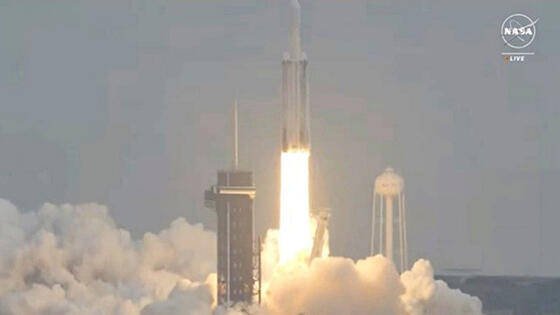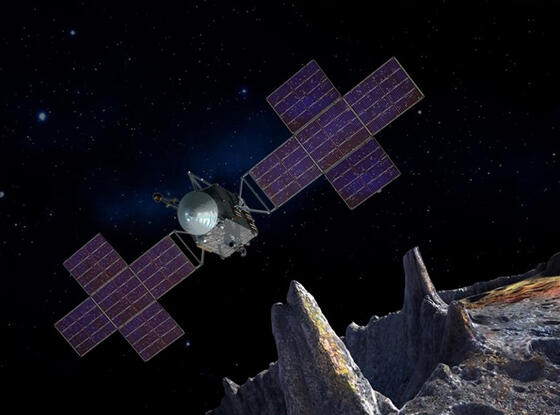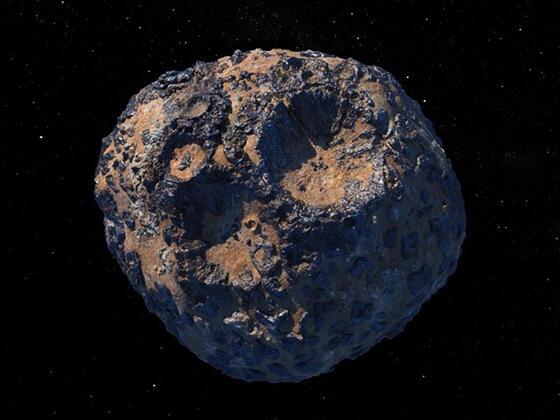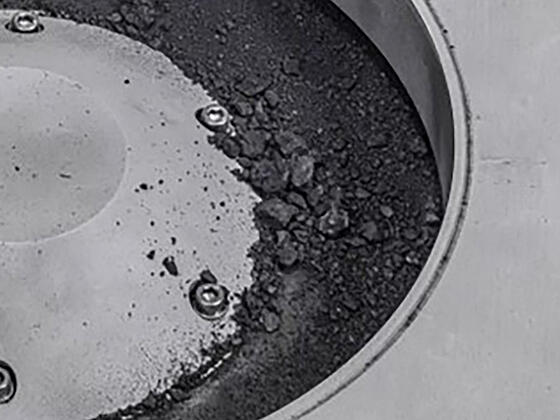'Psyche,' the first U.S. spacecraft to visit a metal-type asteroid, was successfully launched aboard a large SpaceX rocket late at night on October 13, Japan time. The destination is Psyche, an asteroid in the asteroid belt between Mars and Jupiter. Considering that metals such as iron are believed to be present at the center of the Earth, the exploration is expected to help unravel the mysteries of planet formation.
"Opening a treasure trove of science"
Psyche was launched at 11:19 p.m. on October 13 from NASA's Kennedy Space Center in Cape Canaveral, Florida, aboard SpaceX's 'Falcon Heavy' rocket. Approximately 1 hour and 2 minutes after liftoff, Psyche successfully entered its designated orbit. Associate Administrator Nicola Fox of the Science Mission Directorate at NASA said after the launch, "I am excited to see the treasure trove of science Psyche will unlock. By studying the asteroid Psyche, we hope to better understand our universe and our place in it."

Sourced from NASA TV
Psyche is an exploration program led by Arizona State University, with NASA in charge of overall management and operations. The body of the Psyche spacecraft is approximately 25 meters wide with its solar panels open, about the width of a tennis court and weighed approximately 2.7 tons at launch. Along its journey, in May 2026, the spacecraft will use Mars' gravity to speed it along on its way. The spacecraft is scheduled to arrive at Psyche in August 2029 and spend approximately two years exploring. It will not collect samples from the surface of asteroid as Japan's Hayabusa did. This mission was selected in 2017 as part of NASA's 'Discovery Program,' a low-budget program for efficient solar system exploration. The development cost, including launch costs, was approximately US$1.2 billion. The launch was scheduled for August last year but was postponed because of various problems related to the testing of the spacecraft.

Provided by NASA, the California Institute of Technology, Arizona State University, Space Systems/Loral, and Peter Rubin
The asteroid Psyche is located in the outer part of the main asteroid belt, which consists of millions of asteroids of various sizes, and it is 400 to 500 million kilometers (km) from the sun (the distance between the Earth and the sun is approximately 150 million km). It takes five years to revolve around the sun. It appears to be shaped irregularly, like a potato, and has a maximum diameter of approximately 280 km, making it extremely large for an asteroid. Psyche was discovered in 1852 by an Italian astronomer as the 16th asteroid. Its name comes from the name of a beautiful woman in ancient Greek mythology who was loved by Eros, the god of love.
"Journey to the center of the Earth"
The most distinctive feature of the asteroid Psyche is that it is a metal-rich asteroid. 'Itokawa,' which Hayabusa visited, is classified as a rocky asteroid, and 'Ryugu,' visited by Hayabusa2, is classified as a carbonaceous asteroid, but Psyche is very different. Observations so far have estimated that it is made of a mixture of rock, iron and nickel, with metals composing 30% to 60% of its volume while its density ranges from 3.4 to 4.1 tons per cubic meter.
In the early solar system, the Earth and other planets repeatedly collided with smaller celestial bodies. The energy from these collisions is believed to have raised the temperature of the planets, causing rocks to melt, magma oceans to form, and dense metals such as iron to fall off and gather at the center, forming a core. In this process, the outer surface of the planet was stripped away by the collision, and the metal at its core was exposed, which is thought to have become a metal-rich-type asteroid like Psyche.
NASA has likened Psyche's exploration to a "journey to the center of the Earth." This is because it is expected to lead to a better understanding of the Earth's core, which cannot be observed directly. It is also possible that Psyche was not formed through this mechanism but from metal-rich materials somewhere in the solar system.
Psyche's onboard observation instruments include a camera, gamma-ray and neutron spectrometer to identify elements on the asteroid's surface, and a magnetometer to determine if there was a magnetic field in the past. Furthermore, using communications equipment, the rotation, mass, and gravitational field of the asteroid will be determined, and the composition and structure of the asteroid's interior will be explored.

Provided by NASA, the California Institute of Technology, and Arizona State University
Japan and the U.S. actively taking on the challenge of asteroid exploration
Japan and the United States of America are active in asteroid exploration. The main successes include the 2000−2001 exploration of the asteroid 'Eros' by the U.S. spacecraft 'NEAR Shoemaker,' which also succeeded in a soft landing. In the 2010s, the U.S. spacecraft 'Dawn' explored the asteroid 'Vesta' and the dwarf planet 'Ceres.'
The first-ever asteroid sample-return to the Earth was accomplished by Hayabusa in 2010, followed by Hayabusa2 in 2020. On September 24 of this year, the U.S. 'OSIRIS-REx' brought back samples from the asteroid 'Bennu.' On October 11, NASA announced the initial analysis results of the samples, which showed that they contained carbon and water and that "the building blocks of Earth's life may be found in the rocks." Hayabusa2 and OSIRIS-REx (renamed OSIRIS-APEX) are each headed to a second asteroid to be explored, but they will not return to Earth.

Provided by NASA/Erika Blumenfeld and Joseph Aebersold
Going forward, the US spacecraft 'Lucy,' launched in 2021 and currently in transit, will explore eight asteroids between 2025 and 2033. Japan has a plan to launch 'Destiny+,' a technology demonstrator, to explore the asteroid 'Phaethon.'
Exploration of the solar system may be akin to a world far removed from our daily lives; however, the more we investigate it, the more it leads to an exploration of the Earth and life, and, interestingly, the activity helps us learn more about our surroundings and ourselves. Not only planets such as Mars and Jupiter but also small celestial bodies such as asteroids hold the key to this understanding. Through the accumulation of exploration and research, how will humanity's view of the universe change over the next 20 to 30 years and beyond?
(KUSAKA Takeo / Science Portal Editorial Office)
Original article was provided by the Science Portal and has been translated by Science Japan.




